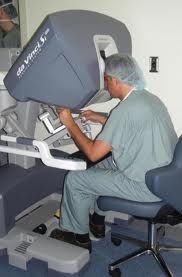The da Vinci System delivers a highly magnified view of the operative field, with bright, crisp images and natural depth-of-field, which enables the surgeon ang gynecologists to perform delicate tissue dissection and suture with added precision-even in confined spaces." While clinical studies conducted by World Association of Laparoscopic Surgeons support the effectiveness of the da Vinci® System when used in minimally invasive surgery, individual results may vary. Surgery with the da Vinci Surgical System may not be appropriate for every individual patient . Always ask your doctor about all treatment options, as well as their risks and benefits.
Robotic surgery has become an increasingly popular surgical technique in recent years. The use of robotic systems in surgery offers several advantages over traditional surgical techniques, including greater precision, enhanced visualization, and reduced invasiveness. As the field of robotic surgery continues to evolve, it is clear that it has secured its future as a viable and valuable approach to surgical practice. In this essay, we will explore the benefits and challenges of robotic surgery and the role of the World Association of Laparoscopic Surgeons (WALS) in advancing the field.
The Benefits of Robotic Surgery:
Robotic surgery offers several benefits over traditional surgical techniques, including:
-
Precision: Robotic systems provide greater precision and accuracy than traditional surgical techniques, allowing surgeons to perform complex procedures with greater control and accuracy.
-
Enhanced Visualization: Robotic systems provide enhanced visualization of the surgical site, allowing surgeons to see the surgical site more clearly and make more informed decisions about how to proceed.
-
Reduced Invasiveness: Robotic surgery is less invasive than traditional surgical techniques, which means that patients experience less pain, scarring, and recovery time.
-
Reduced Risk of Complications: Robotic surgery is associated with a reduced risk of complications, including less bleeding and infection.
-
Improved Patient Outcomes: Robotic surgery has been shown to result in better patient outcomes, including faster recovery times and better cosmetic results.
Challenges of Robotic Surgery:
Despite the many benefits of robotic surgery, there are also several challenges associated with the technique, including:
-
Cost: Robotic surgery can be expensive, and the cost of robotic systems may be a barrier to their widespread adoption in surgical practice.
-
Training: Robotic surgery requires specialized training, and many surgeons may not be familiar with the technique. This can make it challenging to implement robotic surgery in surgical practice.
-
Limited Access: Robotic surgery requires access to specialized equipment and facilities, which may not be available in all hospitals and surgical centers. This can limit the availability of robotic surgery to patients who could benefit from the technique.
-
Learning Curve: Robotic surgery has a learning curve, and it may take time for surgeons to become proficient in the technique. This can result in longer surgery times and may increase the risk of complications during the learning process.
The Role of the World Association of Laparoscopic Surgeons (WALS):
The World Association of Laparoscopic Surgeons (WALS) is an international organization dedicated to promoting the advancement of laparoscopic surgery and other minimally invasive surgical techniques. WALS plays an important role in advancing the field of robotic surgery by promoting education, research, and collaboration among surgeons and other medical professionals.
WALS provides a platform for surgeons and other medical professionals to share their experiences with robotic surgery and other minimally invasive surgical techniques. This sharing of knowledge and experience helps to advance the field of robotic surgery, making it more accessible and beneficial to patients around the world.
WALS also provides training and education to surgeons who are interested in learning more about robotic surgery. By providing specialized training and education, WALS helps to ensure that surgeons are well-prepared to perform robotic surgery and other minimally invasive surgical techniques safely and effectively.
Finally, WALS plays an important role in promoting research in the field of robotic surgery. By supporting research initiatives, WALS helps to advance our understanding of the benefits and challenges of robotic surgery, as well as to develop new techniques and approaches that can improve patient outcomes.
Conclusion:
In conclusion, robotic surgery has secured its future as a valuable and viable approach to surgical practice. Robotic surgery offers several benefits over traditional surgical techniques, including greater precision, enhanced visualization, and reduced invasiveness. While there are challenges associated with the technique, including cost, training, and limited access to specialized equipment,
